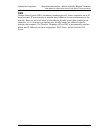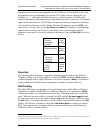
SpectraLink Corporation Setup and Administration—NetLink e340/i640 Wireless Telephone
Mitel Networks 3300 and SX-200 ICP and 5220 IP Phone emulation
Detect dBm coverage
As you walk the perimeter, the two-line display will show the top four access points that
the Wireless Telephone can contact in a code as illustrated below.
XXX1 YY XXX2 YY
XXX3 YY XXX4 YY
-dBm
• XXX1 through XXX4 are the last four digits of the access points’ MAC
address. The primary access point (the access point which had the strongest
signal to this Wireless Telephone) displays first, followed by the three access
points with the next strongest signals.
• YY is the power level in dBm at which this Wireless Telephone heard the
associated access point. Although shown as a positive number, YY represents
negative dBm and lower numbers represent stronger signals. For example, a
displayed value of 40 indicates -40dBm, and is therefore a stronger signal than
a display of 50 (which indicates -50dBm). At least one access point’s reading
should be stronger than -70 dBm in all areas.
Note any areas that have inadequate dBm readings.
Detect Overlap or Conflicts
Press FCN to toggle to the Site Survey function that shows the channel number of the
access points. Use this information to detect overlaps or conflicts in access point
signaling.
XXX1 ZZ XXX2 ZZ
XXX3 ZZ XXX4 ZZ
Chnl
• XXX1 through XXX4 are the last four digits of the access points’ MAC
address.
• ZZ is the channel number that the access point is using.
Note any areas that have access points that are in contention for the same channel.
It is preferable that no overlaps exist anywhere in your facility. If the site survey mode
indicates two APs using the same channel, then at least one other AP must be indicated at
10 dBm stronger than those APs to avoid channel conflicts.
PN: 72-1084-02-D.doc Page 36


















